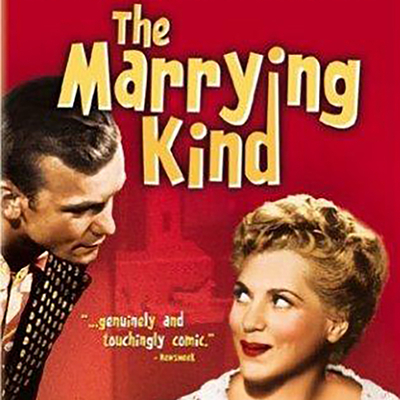That George Cukor's 1952 film The Marrying Kind begins in a divorce court should be something of a warning. But it wasn't enough of one for audiences back then who sat down to enjoy Judy Holliday in a comedy playing the lovable ditz she'd perfected in Adam's Rib and Born Yesterday and got something very different.
It actually begins at the Domestic Relations Court in Manhattan at Lexington and 22nd (now the administrative building for Baruch College) – a lovely bit of New Deal Art Deco architecture where a woman like Judge Anne B. Carroll (played by silent actress Madge Kennedy, who hadn't had a role onscreen since 1928) presides over failing marriages in the age before no-fault divorce.
On the docket is Florence Keefer (Holliday) and her husband Chet (Aldo Ray), who seem no different from the couples in the process of sundering Cukor shows us on the street outside the court, comically fighting and bickering. They want to call it quits on their marriage for no particular reason except that fighting is all they do; in the absence of an affair or bigamy, physical abuse or an illegitimate child, the judge sits them down and asks where they think it went wrong.
The U.S. divorce rate reached its high point in 1980, when we were told that it was statistically probable that half of all marriages would end in divorce. In 1950 it was just twenty per cent and would remain low until the end of that decade, when it began its vertiginous twenty-year rise. Divorce still had a social stigma, and in the age before no-fault decrees it was hard to prove cause, so it was known as just one of several luxuries reserved for the rich.
(Today, however, divorce and illegitimacy are what poor people do, while stable nuclear families are more common the richer you are. Perhaps they always were but making divorce and single parenthood aspirational boomeranged back hard on the working class like so many other "revolutionary" changes that began in the '60s.)
By this point audiences had sat through the jaunty titles music and credits like "Gowns by Jean Louis"; the broadly-drawn aggro of the crowd outside the court had also done a lot to make them relax in their seats and get ready for a gentle satire of modern marital mores from the team that had already made comic gold like Adam's Rib and Born Yesterday, which included Holliday, Cukor and husband-and-wife screenwriting team Garson Kanin and Ruth Gordon, with the addition of newcomer Ray.
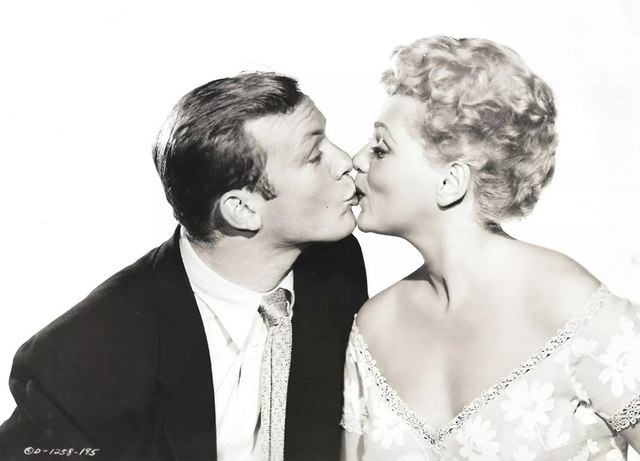
Columbia studio chief Harry Cohn had imagined The Marrying Kind as a vehicle to launch Ray, his new discovery. Aldo Da Re was born in Pennsylvania but his family moved to California when he was four, where his father got a job working at a sugar refinery while young Aldo distinguished himself as a high school athlete. He joined the Navy and become a frogman, shipping out just in time to see action at Okinawa. Back in California studying political science on the G.I. Bill, he didn't imagine anything like a career in movies until a unit from Columbia arrived in San Francisco looking for athletes to appear in Saturday's Hero (1951), a now-obscure picture starring John Derek and Donna Reed that somehow mashed together film noir and sports.
He'd been signed to a seven-year contract with Columbia but got himself suspended when he was elected constable of the Crockett Judicial District and told the studio he preferred a career in politics. But Ray got bored with public service and asked if Columbia had any work for him; he was sent to do a screen test with Cukor, who thought he walked too much like a football player but was as impressed with Ray as Harry Cohn. It was an auspicious start.
Ray is something of a footnote now, but he was a contender in the first half of the '50s. After The Marrying Kind he starred alongside Jane Wyman and Rita Hayworth in 1953, and Cohn wanted him for the role in From Here to Eternity that went to Montgomery Clift. The highlight of his career was probably when he was loaned out to appear in Raoul Walsh's Battle Cry in 1955, and he developed enough of a swelled head that he walked off the set of My Sister Eileen the same year, complaining that his role was too small.
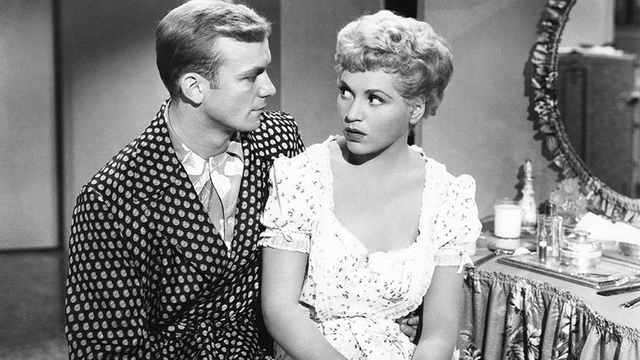
In the judge's chambers at the divorce court, Florence and Chet are asked to recall how they met, seven years earlier in Central Park. Neither of them remember it as "anything special"; he calls it a "pick up", she sharply disagrees. Right from the start Cukor wants us to know that they're unreliable narrators of their own story.
After a brief courtship as half of a pair of couples they get married and spend their honeymoon in Atlantic City, a gift from her sister, who lucked into marrying a rich man. They move into an apartment in Peter Cooper Village, in Stuyvesant Town, the postwar tower block development on the far side of Alphabet City – a planned (and at that time segregated) community built by Metropolitan Life, who owned it until 2006. (It's now owned by Blackstone.)
We're told that Florence has left her job, and that Chet's income working at the James Farley Post Office Building near Penn Station (now Moynihan Train Hall) is $2300 a year (just over $27,000 today). Their apartment is nearly empty when they move in, with folding chairs and mattresses on the floor, and a big console radio that was a wedding gift from her former boss.
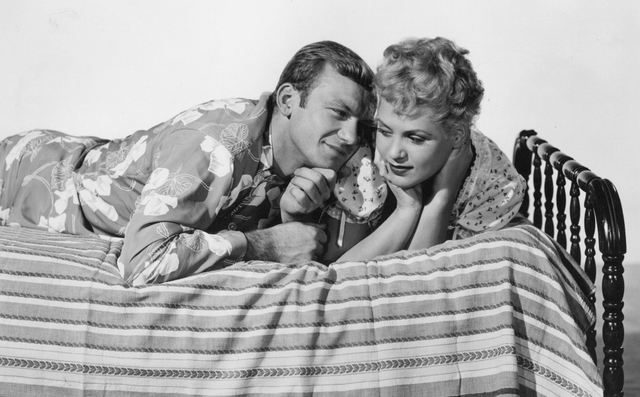
Over the course of the movie their flat fills up with furniture. New acquisitions are talked about, like the silverware she got from her sister, a "real leather" cigarette case and a wallet he gets from his co-workers (along with a joke gift – ear plugs) that he insists will be his "special occasion wallet". (Bonus points if you spot Charles Bronson among Chet's post office co-workers.)
This part of Cukor's movie rings true; my father had made the transition from blue collar to white collar worker at Supertest, the (long defunct) Canadian oil and gas company, around this time. Consumer culture was emerging but individual possessions still had abiding value, especially if they were status acquisitions – crystal glassware, china, silverware or electronics – and like anything in a family home in recent, much leaner times, were expected to last years, even decades.
From the first day of their marriage Chet's worried about money, even more after children start arriving; he tells the judge that it preoccupied him constantly, making him distracted and joyless, though the flashbacks we see don't really bear this out. They're invited to a party seeing off her sister and brother-in-law on a month-long trip to Europe – an evening wear event that requires Chet to change at work and clean up a last-minute machinery breakdown, scooping up ball bearings while in his tuxedo.
(Like so many films made in the first half of the '50s, The Marrying Kind provides a glimpse of an adult-focused world, where children are still in the background, and even a couple like Florence and Chet, somewhere on the cusp of working and middle class, feel obliged to own evening clothes.)
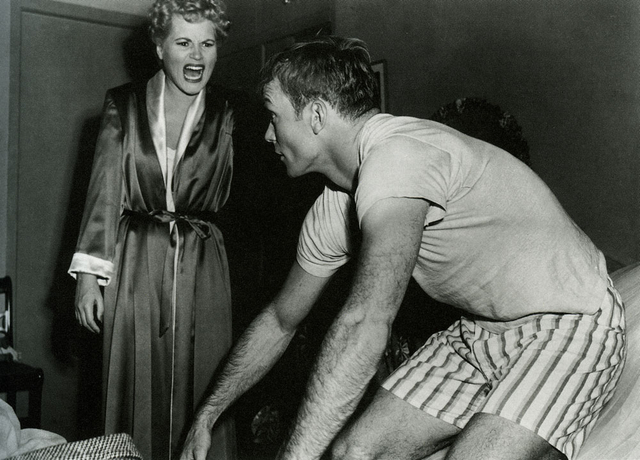
Chet insists that he was sullen and disengaged at the party, uncomfortable with what he describes as his in-laws' condescension; the flashbacks show him warmly welcomed, knocking back drinks and becoming the life of the party, flirting with a tall brunette while dancing the rhumba. They arrive home soused and angry, Florence more than Chet, full of recriminations, excuses and denials.
The whole scene is mostly played for laughs but there's an uncomfortable edge, and it segues into a dream sequence: Chet, still in his underwear and sock garters, is drawn from his bed into one of the sorting chutes at the post office, where he's confronted by the ball bearing spill he left on the floor, now apparently growing, sentient and pursuing him. His boss arrives in evening wear and tells him that not just the Postmaster General but the President himself are on their way for a surprise inspection.
The commander in chief arrives in an Atlantic City boardwalk rolling chair with military detail and takes a pratfall on the carpet of ball bearings. His military escort pursue Chet up and down the sorting chutes with orders to shoot to kill, and he escapes onto the streets of midtown Manhattan in his underwear, only to be confronted by a firing squad of Florences who gun him down on the sidewalk.
Chet believes that it only takes ten seconds of actual thought and inspiration to produce an idea that can make you a fortune; this is an only slightly more proactive version of the hopeful ideal that makes so many working people spend a cumulative fortune on betting pools or the lottery. But he emerges from his nightmare with an inspiration – a pair of roller skates with ball bearings on the soles.
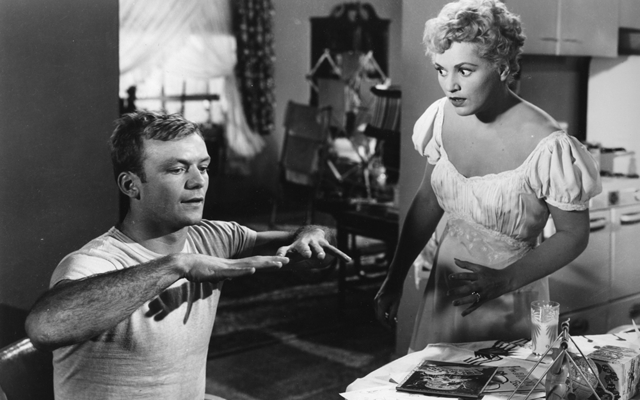
Cukor is still playing up the comedy when they approach her sister's rich husband to help patent and finance the idea, but it all ends badly when the brother-in-law takes a spill testing out the skates and Florence decides the best thing to do with the unconscious man is to empty a pitcher of water on his head. (Holliday's character has a fixation that almost any situation can be helped with a glass of water or milk, depending on the problem: a nightmare requires milk.)
Not long afterward they read in LIFE magazine that a former dance instructor has hit it big with ball bearing roller skates. They've only just recovered from this blow when Florence is called by a radio station to compete for the prize in their "Name That Tune" competition. Chet bullies her into choosing his wrong answer over her correct hunch. There's a kernel of humour in each of these situations, but with each setback Cukor plays it for fewer laughs.
At this point in the film audiences must have suspected that the comic romp they were promised wasn't on its way. A solid hunch, but they couldn't have been prepared for what comes next.
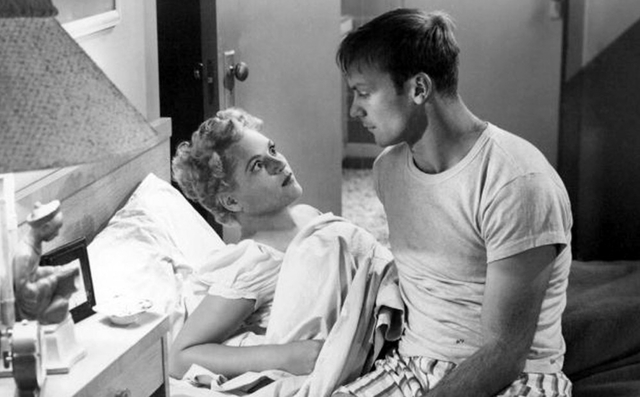
Judy Holliday had just come through a crisis when she made The Marrying Kind. Her new fame had put her under scrutiny, and she'd been included along with 150 other alleged communist sympathizers in Red Channels, which landed her in front of Sen. Pat McCarran's Senate Internal Security Subcommittee. She'd been advised to appear in front of the committee playing Billie Dawn – to play dumb – and she managed to survive her appearance without naming names or damaging her reputation with the studios.
One is obliged, when talking about Judy Holliday, to note that the character she played in most of her movies was just that, and that the real woman was nothing like Billie Dawn. She was, as Cukor himself said in Richard Schickel's The Men Who Made the Movies, an "extremely intelligent, intellectual person – very well educated, very highbrow, very musical, and she was unique...And then, of course, she was a master of comedy and subtlety, and of understatement. She was a brilliant actress. And then with the other pictures I did with her, I found her marvelous and modest and, in retrospect, infinitely touching."
The Marrying Kind was supposed to be a departure, and not just for Holliday. In his biography of the actress William Holtzman writes that it "was a transitional film for many. Ruth Gordon and Garson Kanin were swapping their facile patrician romanticism for a measure of popular realism. This was also a departure for Cukor along similar lines. For Harry Cohn this was a perfect vehicle for his proud find, Aldo Ray. Judy, who was less that thrilled with Ray, was more than thrilled with this opportunity to put Billie Dawn behind her for good. Her character, Florence Keefer, had none of Billie's traits or idiosyncrasies - the Kanins saw to that. For the first time Judy could build a role from scratch for film."
Which was fine in theory but in practice the film underdelivers, and I can't help but put it down to how smart, enlightened, liberal people like Gordon, Kanin and Cukor regarded their idea of people like Florence and Chet.
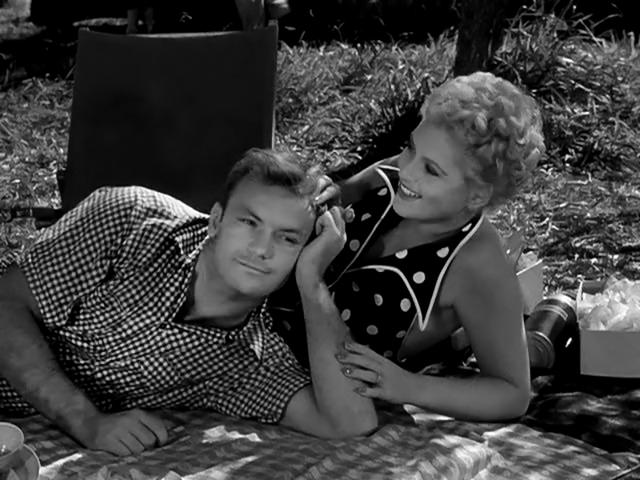
Early in the film Florence reflects on her honeymoon, and the opportunity it gave her to sit down and just think about things; she says she was "surprised at how enjoyable" it was and resolves to try it again. It sounds like the sort of thing intellectuals imagine working people say to themselves, given the rare opportunity for a respite from whatever they think working people do – work, one presumes, and fight, if you go by what goes on for much of The Marrying Kind.
As for Aldo Ray's Chet, I'm still not sure if I dislike the actor or the character, or both. The actor plays Chet with a hoarse "dese and dose" outer borough accent, struggling to articulate his thoughts beyond a despairing "I dunno" when forced to explain his actions. For most of the film he's impulsive and self-pitying, an overgrown boy, and while his worries about money are understandable, his solutions often reflect what he admits are "delusions of grandeur."
And still, the film has real dramatic power once it finally discards the pretense of being a comedy with a tragic, heartbreaking scene that very nearly destroys Florence and Chet's marriage just when it seemed to find some equilibrium. Holliday and Ray make us feel every corrosive facet of their heartbreak. As Holtzman writes:
"This was not the sneaky glamour of the shopgirls Joan Crawford used to play. Florence was realistic with traits that ran from annoying to endearing, and a slightly bewildered pathos that was quietly fascinating. Judy showed critics and the public that she was not a one-note comedienne but an actress with sensitivity and range. The film displayed her to excellent advantage: she had a shattering dramatic scene in which her young son drowns at a family picnic. She even got to sing the catchy 'Dolores' while accompanying herself on the ukelele. The performance gave every indication of initiating the transition from Billie Dawn that Judy wanted. She was so good that she even made a better actor of the callow Also Ray, whom she generously helped on the set but thought little of personally because of his drinking and apparent low opinion of women."
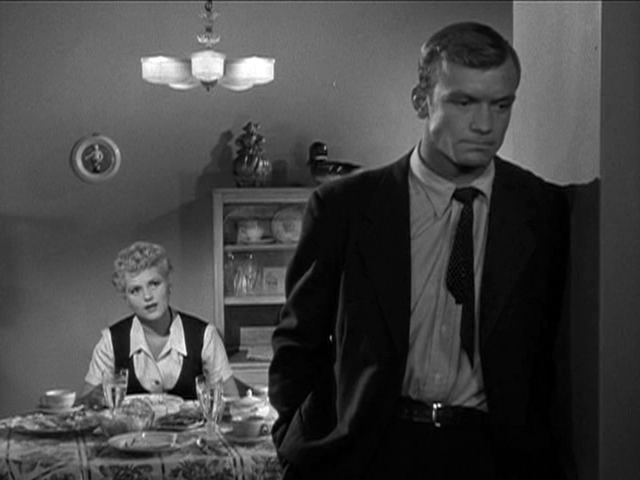
Perhaps because sensible people still didn't imagine that a married couple with children would pull the plug on a marriage because it didn't live up to their fantasies, the Keefers are shamed by the Judge when forced to explain themselves. They resolve "not to blame each other when things go the wrong way" before Cukor gives them a low-key moment of reconciliation before as the final credits roll.
In the end Florence Keefer wasn't enough of a departure from Billie Dawn to raise Holiday above the typecasting that would persist for the rest of her short career. She was far too great an actress not to imbue the best of her undeniably similar subsequent roles – Gladys in It Should Happen to You, Laura in The Solid Gold Cadillac, Ella in Bells Are Ringing – with real personality and the unforced pathos that made her whole persona so unique, then and now.
Club members can let Rick know what they think by logging in and sharing in the comments below, as access to the comments section is one of many benefits that comes along with membership in the Mark Steyn Club.


